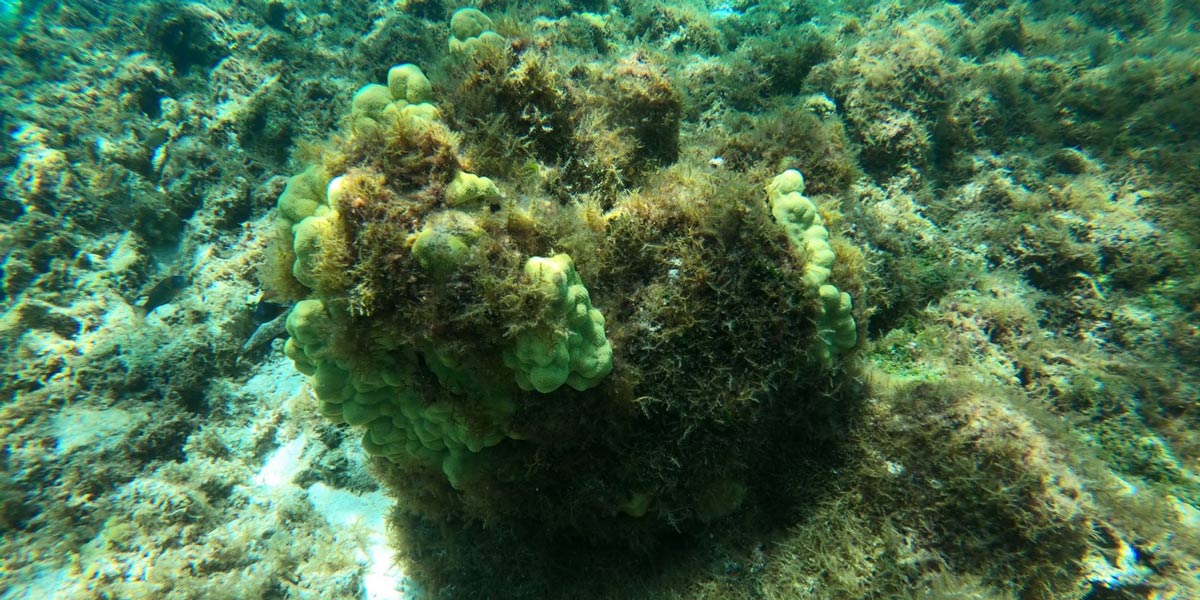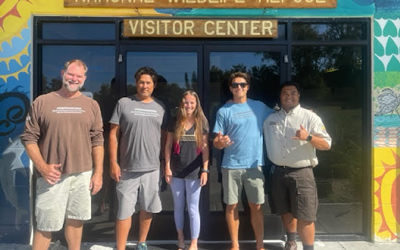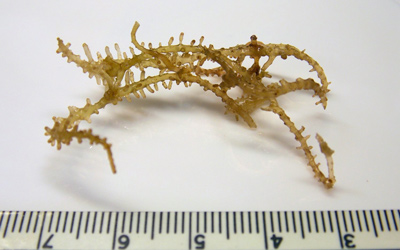News
Researchers collect data on nuisance red alga at Kuaihelani in Papahānaumokuākea Marine National Monument


Researchers recently returned from an expedition to Kuaihelani (Midway Atoll) in Papahānaumokuākea Marine National Monument after collecting data related to a nuisance seaweed, Chondria tumulosa. The mission was a collaborative effort among scientists from NOAA, the University of Hawaiʻi, the College of Charleston, and U.S. Fish and Wildlife Service (USFWS) at Midway Atoll National Wildlife Refuge and Battle of Midway National Memorial.
Chondria had been observed around Kuaihelani in 2021 by teams targeting marine debris removal. Thick mats of it were documented in 2019 and 2021 at Manawai (Pearl and Hermes Atoll), overgrowing and smothering native corals and algae. The origin of this alga is a mystery and very little is known about its ecology, physiology, or potential biological drivers. It was identified as a species new to science in 2020, and to date is only known from these two atolls globally.
The research focus of the Kuaihelani expedition was to investigate the ecology and physiology of the nuisance alga and determine the oceanographic conditions that might be fueling its growth.
“This research is necessary for us to better understand what’s driving the explosive growth of this new alga,” said Brian Hauk, resource protection specialist for Papahānaumokuākea Marine National Monument. “We learned a lot during this expedition and we have a lot of data to examine in the upcoming months and years.”
Distribution Surveys
More than 150 sites were surveyed over the 17-day mission to determine the spatial extent and coverage of the alga. Chondria was observed at 30% of the sites inspected but only in high abundance at eight sites. The patterns of distribution at Kuaihelani are similar to those researchers found at Manawai in 2021, but with less mass formation.
“From the sites we surveyed here at Kuaihelani, Chondria doesn’t seem to be forming as many of the thick mats that we have observed at Manawai in previous years,” said Taylor Williams, College of Charleston.
Notably, at most sites, Chondria was not highly visible and found mostly at the base of corals, under rocks, and growing entangled with native algal species. This makes it more difficult to locate, either in the water or from the air.
Sample Collection

Specimens were collected to investigate Chondria’s population structure, reproductive state, composition, and associated invertebrate communities. Specimens will help scientists understand the biology, ecology, and physiology of this species.
“We will compare the population structure between Manawai and Kuaihelani to determine if these atolls consist of one Chondria population or if they have distinct populations,” Taylor Williams said.
Oceanography
Oceanographic data on temperature, nutrient levels, and other parameters were collected at over 75 different sites. Collections will help determine what is influencing the distribution and spread of Chondria and other native algal species observed in high abundance at Kuaihelani.
Detecting and Preventing Future Spread
Researchers and managers are concerned about the potential spread of Chondria to other locations in the Hawaiian Archipelago. Spread is possible due to Chondria’s ability to form dense mats, fragment easily, and the assumption that it can reproduce both sexually and asexually.
As a preventative measure, scientists conducted experiments to determine the lethal parameters required to kill algal fragments. Sample fragments were subjected to a variety of chemical treatments, sun and shade exposures, and freezing treatments. The results will help with developing best management practices to prevent accidental spread via entanglements in boats or dive gear.
Early detection and rapid response are also important to preventing the spread of a nuisance species. Part of the team, at the University of Hawaiʻi, is using water samples collected at Manawai and Kuaihelani to develop a test to detect the presence of Chondria DNA in the water before it begins to smother corals. The research will provide a valuable management tool for interpreting DNA signals in future surveys with minimal human effort and expertise.
Research
The research expedition was supported by NOAA’s Office of National Marine Sanctuaries and USFWS, and was partially funded through grants and cooperative agreements from the National Fish and Wildlife Foundation, USFWS, and Robert F. Orr Foundation. The expedition included researchers and support from the College of Charleston, University of Alabama, University of Hawaiʻi, and staff from NOAA’s Office of National Marine Sanctuaries and Papahānaumokuākea Marine National Monument employed through the Cooperative Institute of Marine and Atmospheric Research.



